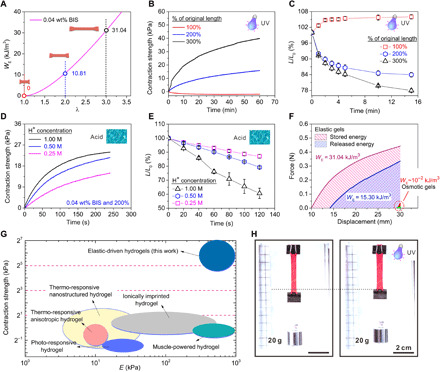Fig. 3. Contractive properties of EDG.

(A) Elastic energy density (WE) of EDG (0.04 wt % BIS) contraction as the function of prestretch ratio (λ). (B) EDG’s contraction strength versus UV radiation time for EDGs with different prestretch ratio. (C) Length ratio (L/L0) as a function of UV (320 to 390 nm, 225 mW/m2) radiation time was measured in water. (D and E) Contraction strength-time and length ratio-time curves of the EDG (200% energy storage, cross-linker: 0.04 wt % BIS) in 0.25, 0.5, and 1 M hydrochloric acid solution. (F) Stored energy and released energy of EDG, in comparison with the released energy of osmotic hydrogels. (G) Comparison of the contraction strength and elastic modulus between EDGs and typical osmotic hydrogels (1, 3, 14, 40, 41). (H) Photos of an EDG (300% energy storage, 0.04 wt % BIS) strip lifting a 20-g weight load upon UV light illumination. (Photo credit: Yanfei Ma and Shuwang Wu, University of California Los Angeles.)
